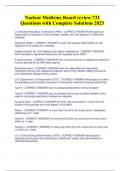Exam (elaborations)
Nuclear Medicine Board review-732 Questions with Complete Solutions 2023
- Course
- Institution
Nuclear Medicine Board review-732 Questions with Complete Solutions 2023 U.S Nuclear Regulatory Commission (NRC) - CORRECT ANSWER what agency is responsible for regulation of the purchase, receipt, use, and disposal of radioactive materials Agreement State - CORRECT ANSWER a state that acce...
[Show more]



